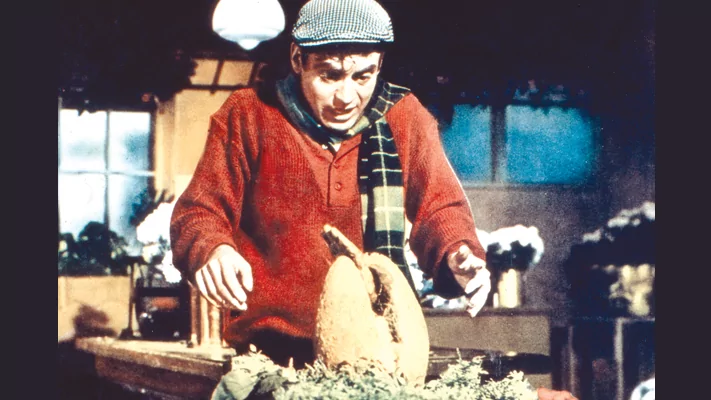
The directive to “go West, young man” has been an American adage for almost 200 years. Many attribute it to the pre-Civil War-era New York newspaperman Horace Greeley, but it may be even older than that. The guidance gained legions of adherents after gold was discovered in Northern California in 1848. These four famous words became even more deeply ingrained in our cultural consciousness after the birth of the movie industry in the early 20th century. Among the droves of young men who went West in the early 20th century, drawn by the magic of the movies, was a Pennsylvanian son of Austrian immigrants who dreamt of a career in Hollywood. Although he never became a star on the level of a Gary Cooper or a Humphrey Bogart, he earned enough roles to make a life for himself in the movies and even made one movie, Little Shop of Horrors, that would later take on a life of its own.
This westward-bound young man was Jonathan Haze, the prolific actor, producer, screenwriter, and Little Shop of Horrors star who died on Nov. 2 in his adopted hometown of Los Angeles. He was born Jack Aaron Schachter in Pittsburgh on April 1, 1929, and it helped that he had a famous family member who was already in show business — his cousin Buddy Rich, the Brooklyn-born bandleader who some consider the greatest drummer of all time. After working for his illustrious cousin, Haze landed a two-year gig as dancer-singer Josephine Baker’s stage manager. After acting in summer theater troupes in Connecticut, Haze hitchhiked his way to Los Angeles, where there were no roles waiting for him there that matched the glamorous opportunities he had had with Baker and Rich. Compelled to start at the bottom just like everyone else, Haze got a job at a Santa Monica Boulevard gas station, biding his time while hoping to catch on somewhere in the land of broken, and occasionally realized, dreams.

His big break came when a man with movie connections happened to drive into Haze’s gas station one day. The man, an aspiring director named Wyott Ordung, introduced Haze to Roger Corman, the up-and-coming filmmaker who was on his way toward becoming the greatest B-movie director in the history of American cinema. Corman told Haze that he could cast him in one of his movies if Haze would bring his own costumes and do his own stunts. And he wouldn’t be paid overtime, either. “You still want it?” Corman asked him. For a young movie-obsessed man like Haze, was it ever even a question?
The movie, Monster From the Ocean Floor (1954), would be the first of Haze’s 50-plus acting, producing, and screenwriting credits during a near-60-year movie career. And, in the tradition of stars like Cary Grant and John Wayne who had changed their names to make them more screen-friendly, Monster From the Ocean Floor was also the movie in which he’d go by his adopted stage name of Jonathan Haze (though at that time he was still spelling it as “Hayes”).
Working with Corman would establish Haze as a reliable B-movie actor, but it also meant he would have to get used to directorial minimalism. During the 1955 Corman Western Apache Woman, Haze was part of a barebones cast that played the Cowboys as well as the Indians for the simple reason that Corman didn’t want to pay for two separate sets of actors. And because of Corman’s movies’ shoestring budgets, the director would try to shoot them in under a week. Little Shop of Horrors (1960), the movie that gave Haze his most memorable role, was shot in only two days. (And you thought Clint Eastwood had a reputation for working quickly!) In this campy Corman cult classic, Haze plays a nebbishy flower shop salesman named Seymour Krelborn whose fortunes take a turn when he discovers that one of the store’s more promising plants will only grow if it’s fed human blood. “Well,” Haze remarks, “I guess there’s no accounting for people’s tastes.” The movie’s absurdist Marx-Brothers-do-horror quality never lets up. In another scene, Krelborn, needing to pretend to be a dentist (don’t ask), has to pull the teeth of an unsuspecting and oddly dental-work-loving patient named Wilbur Force, played by Jack Nicholson, in one of the acting great’s earliest roles.
CLICK HERE TO READ MORE FROM THE WASHINGTON EXAMINER
Haze would go on to make nearly two dozen films with Corman before breaking out into other areas of the movie business — screenwriting, production management, and producing. He also enjoyed success as a TV commercial producer for brands such as Kool-Aid and other well-known companies.
No matter what project he was working on, and no matter how challenging the movie’s circumstances were, he always maintained an uncompromising and admirable degree of professionalism. As Jackie Joseph, his co-star in Little Shop of Horrors, said about Haze’s role in the movie (for which he was paid only $400): “I don’t think any of us would have been as successful if he hadn’t been on top of what he was doing.”
Daniel Ross Goodman is a Washington Examiner contributing writer and the author, most recently, of Soloveitchik’s Children: Irving Greenberg, David Hartman, Jonathan Sacks, and the Future of Jewish Theology in America.







